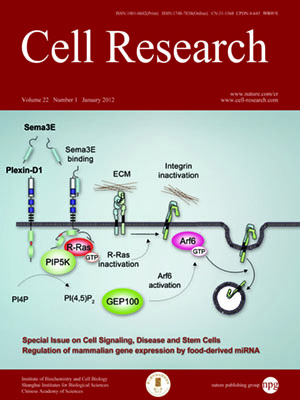
Volume 22, No 1, Jan 2012
ISSN: 1001-0602
EISSN: 1748-7838 2018
impact factor 17.848*
(Clarivate Analytics, 2019)
Volume 22 Issue 1, January 2012: 168-177
ORIGINAL ARTICLES
The metabolome of induced pluripotent stem cells reveals metabolic changes occurring in somatic cell reprogramming
Athanasia D Panopoulos1,*, Oscar Yanes2,3,*, Sergio Ruiz1, Yasuyuki S Kida1, Dinh Diep4, Ralf Tautenhahn2, Aída Herrerías5, Erika M Batchelder1, Nongluk Plon
1Gene Expression Laboratory, The Salk Institute for Biological Studies, 10010 North Torrey Pines Road, La Jolla, CA 92037, USA
2Departments of Chemistry and Molecular Biology and Scripps Center for Metabolomics and Mass Spectrometry, The Scripps Research Institute, La Jolla, CA 92037, USA
3Metabolomics Platform of the Spanish Biomedical Research Center in Diabetes and Associated Metabolic Disorders (CIBERDEM), University Rovira i Virgili, 43007 Tarragona, Spain
4Bioinformatics and Systems Biology Graduate Program, University of California at San Diego, La Jolla, CA 92093, USA
5Center of Regenerative Medicine in Barcelona, Dr Aiguader, 88, 08003 Barcelona, Spain
6Department of Bioengineering, Institute for Genomic Medicine and Institute of Engineering in Medicine, University of California at San Diego, La Jolla, CA, 92093, USA
7Stem Cell Core, The Salk Institute for Biological Studies, 10010 North Torrey Pines Road, La Jolla, CA 92037, USA
8Howard Hughes Medical Institute, The Salk Institute for Biological Studies, 10010 North Torrey Pines Road, La Jolla, CA 92037, USA
Correspondence: Gary Siuzdak, Juan Carlos Izpisua Belmonte,(siuzdak@scripps.edu; belmonte@salk.edu; izpisua@cmrb.eu)
Metabolism is vital to every aspect of cell function, yet the metabolome of induced pluripotent stem cells (iPSCs) remains largely unexplored. Here we report, using an untargeted metabolomics approach, that human iPSCs share a pluripotent metabolomic signature with embryonic stem cells (ESCs) that is distinct from their parental cells, and that is characterized by changes in metabolites involved in cellular respiration. Examination of cellular bioenergetics corroborated with our metabolomic analysis, and demonstrated that somatic cells convert from an oxidative state to a glycolytic state in pluripotency. Interestingly, the bioenergetics of various somatic cells correlated with their reprogramming efficiencies. We further identified metabolites that differ between iPSCs and ESCs, which revealed novel metabolic pathways that play a critical role in regulating somatic cell reprogramming. Our findings are the first to globally analyze the metabolome of iPSCs, and provide mechanistic insight into a new layer of regulation involved in inducing pluripotency, and in evaluating iPSC and ESC equivalence.
Cell Research (2012) 22:168-177. doi:10.1038/cr.2011.177; published online 8 November 2011
FULL TEXT | PDF
Browse 2426


